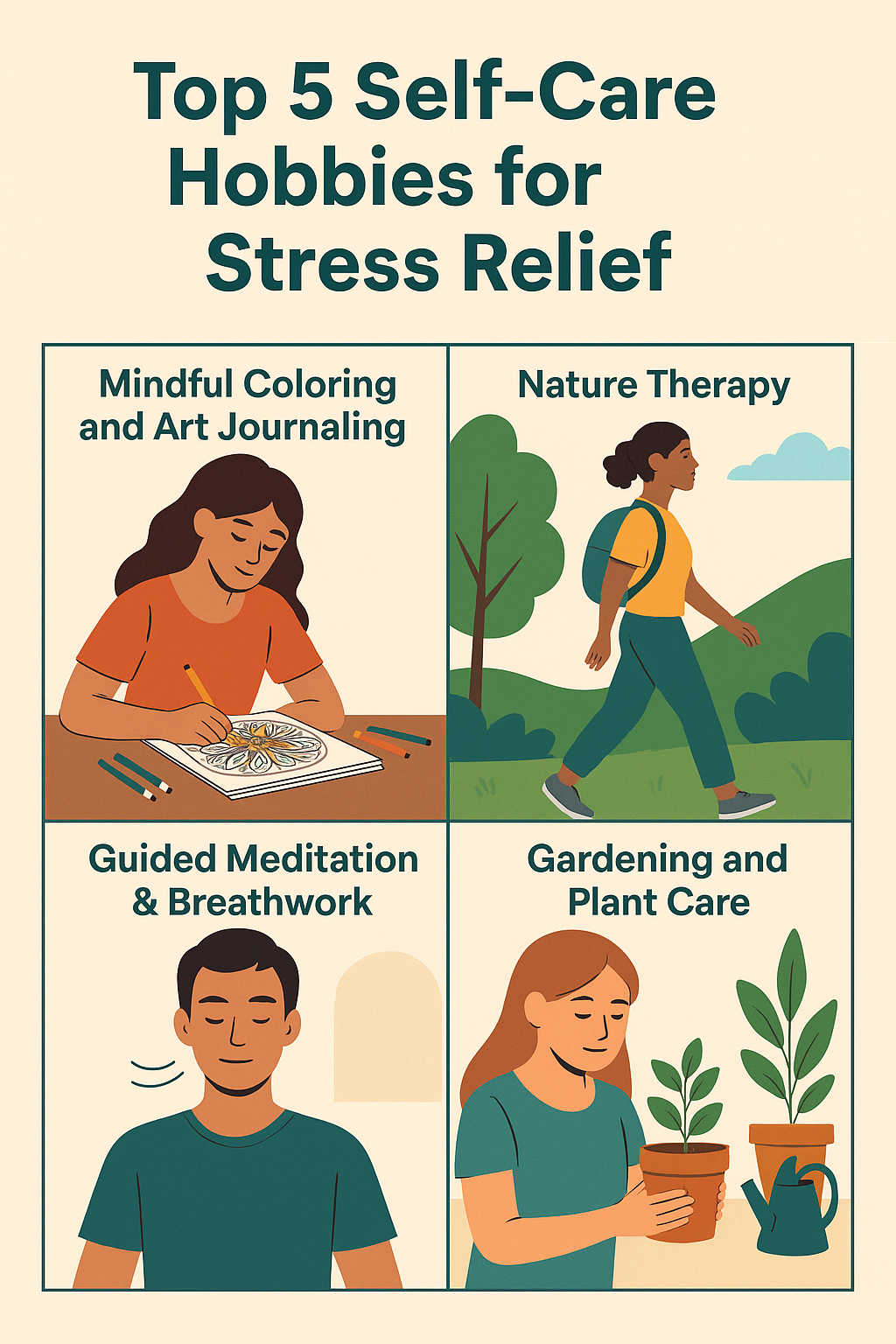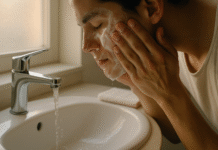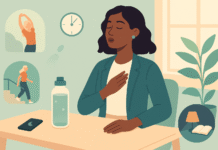In our fast-paced, hyperconnected society, stress is nearly always there. When you have a lot going on at work and in your personal life, it can be easy to feel like you can’t handle it all. Long-term stress can impair your memory, make you more likely to get sick, and make you feel nervous or depressed, according to research. You don’t have to spend a lot of money on spas or long vacations to feel better, though. You can find it in simple, fun things that are beneficial for your body and mind.
Things you do on purpose to feel better mentally, emotionally, and physically are called self-care hobbies. They assist your nervous system get back on track and bring everything back into balance by using flow states, mindfulness, creativity, and movement. The nicest aspect is that you don’t have to buy a lot of expensive instruments or take a lot of training. You just need to be willing to try new things and give yourself some time.
This whole guide will show you the Top 5 Stress-Relieving Hobbies for Self-Care and give you expert perspectives and scientific facts to back them up. You’ll see:
- A clear picture of why hobbies that help you take care of yourself are excellent for you
- In-depth overview of each pastime, including its advantages and downsides, how to begin, and more advanced versions
- Helpful tips for fitting these items into a hectic schedule
- Things that people commonly want to know
- A summary that covers the important ideas and informs you what to do next
- A selection of reliable sources with links to them that was carefully chosen
- How to use your hobbies to relax and take care of yourself
What Stress Is and How to Handle It
When you’re anxious, your body makes adrenaline and cortisol, which makes you want to “fight or run.” This system can be useful in crises, but if you leave it on all the time, it can:
- Swelling and high blood pressure
- Problems in learning and remembering
- More prone to develop mood issues
You can stop this loop by doing things you like. Hobbies turn on the parasympathetic nervous system, which is in charge of “rest and digest.” They also create more endorphins and dopamine. They also assist people enter into flow states, which are periods when they are so concentrated on what they are doing that they lose track of time. These emotions are connected to less stress and more enjoyment.
How to Choose the Best Hobby for Your Health
Before we discuss about your options in more depth, think about:
- Do you like to do things that are artistic, relaxing, or physical? What do you like to do and what do you believe in?
- Do you have a couple hours a week or ten minutes a day to spare?
- Do you need extra room or equipment to get what you need?
- When you are with other people or when you are alone, do you learn better?
Before you read about the interests below, think about these things.
1. A Quick Overview of Mindful Coloring and Art Journaling and Their Benefits
Art can help a lot of individuals heal. Mindful coloring, which is drawing in complex patterns with colored pencils, is like formal mindfulness meditation in that it keeps you in the moment. You can deal with your feelings by drawing, collaging, and writing in an art journal in a free-form style.
The main benefits are:
- It helps you stop being hard on yourself and overthinking things.
- It helps you understand yourself better and manage your emotions.
- It’s simple for novices; you don’t have to be an artist.
What You Need to Start
- A set of colored pencils or markers, such as Prismacolor Scholar pencils.
- A blank diary, with or without lines, or coloring books that are already printed, like Johanna Basford’s “Secret Garden.”
How long it will take:
- Begin with 10 to 15 minutes each day.
- Set it up as a “brain break” in the middle of the day or just before bed.
How to do it:
- Keep an eye on how the colors change and how hard you press the pencil.
- When you write in your journal, alternating between creating random shapes and putting down your feelings.
For more advanced variations:
- Incorporate magazine clippings, fabric scraps, or natural items like leaves and flowers in a mixed-media collage.
- Use prompts like “Draw your stress as a color” or “Draw a safe place” to make you think.
- Join an art therapy group in your neighborhood or online, like r/ArtJournaling on Reddit.
2. Nature Therapy: Wandering in the City or on a Path
Walking is a terrific way to get some aerobic exercise and go outside, especially in parks and other green spaces. Research in Japan has found that “forest bathing” (shinrin-yoku) decreases cortisol levels and makes people feel better. Walking in the city might also be helpful for you if there aren’t many natural parks nearby.
Main Benefits:
- Lowers blood pressure and heart rate.
- Raises vitamin D levels, which is helpful for the immune system.
- Combines exercise with being aware of your surroundings when done slowly and properly.
Things to do first:
- Shoes that are simple to walk in, like Brooks Ghost.
- Bring garments that will keep you warm and dry when you’re in the water.
Making a plan for your trip:
- Use Google Maps or AllTrails to find parks close to you.
- Choose tree-lined avenues or shoreline paths to wander throughout the city.
Exercise for walking with awareness:
- First, notice how you’re breathing.
- Check out the sights, sounds, smells, and textures under your feet, as well as the people and birds surrounding you.
- Take your time and pay attention to how each step feels.
Changes that are more advanced:
- Photo Walks: Take images of flora or places that interest you.
- Nature Journaling: Draw or write about the animals and plants you see.
- Community Groups: Look for a group in your neighborhood that goes for walks or hikes.
3. A Look at Guided Meditation and Breathwork and How They Can Help You
Breathwork and meditation have a tremendous effect on the nervous system, which functions on its own. Some of the different methods are gradual muscle relaxation, guided imagery, and diaphragmatic breathing. Meta-analyses suggest that symptoms of stress, anxiety, and depression have dropped a lot.
The main benefits are:
- A fast decline in bodily indications of stress, such as heart rate variability going up.
- More brain capacity, focus, and mental strength.
- You may use it anywhere, including at work, at the park, or on a bench.
How to Start: Apps and Tools
- All three of these apps—Headspace, Calm, and Insight Timer—have free introductory series.
- Yoga with Adriene and other YouTube videos offer both mindfulness and movement.
Breathwork Basics
- Box Breathing: Breathe in for four seconds, hold it for four seconds, let it out for four seconds, and then hold it for four seconds. For five minutes, do this.
- In for four seconds, out for seven seconds, and out for eight seconds.
Location:
- Find a peaceful spot and, if you need to, put on headphones that block out noise.
- Stand up straight or lie down with your back straight.
Versions that are better
- Breathing in and out quickly is called Kundalini Breath, or Breath of Fire, and it gives you greater energy.
- Guided Body Scan: Relax each muscle group, starting with your toes and working your way up to your head.
- Think about inhaling in serenity (blue light) and breathing out stress (gray smoke).
4. A List of the Good Things of Taking Care of Plants and Gardening
Taking care of plants gives us a purpose and ties us to the cycles of life. Gardening has been proved to make people feel better and less depressed, especially senior people. Taking care of houseplants also makes the air cleaner and the space appear nicer.
The key benefits are:
- You can ground yourself with your hands and more than one sense.
- Promotes routine and taking care of things.
- Gardens that are helpful for pollinators are also good for the Earth.
How to Get Started: Inside or Outside
- If you’re going to keep plants inside, start with jade plants or pothos, which are easy to care for.
- You can plant herbs and vegetables in pots on a balcony or in raised beds outside.
Things to Remember:
- Pots with holes on the bottom to let water out, dirt for the pots, a hand trowel, and a watering can.
- A soil test kit or a pH meter can help you keep track of the nutrients in your soil.
Taking Care of Regularly:
- Water the plants deeply but not too regularly to help the roots grow.
- To get rid of bugs naturally, find them and spray them with neem oil.
Changes that are more advanced
- Use basil, mint, or rosemary from your herb garden to cook with.
- Wall planters are great for small locations that want to grow vertical gardens.
- Rent a spot in a community garden to meet other gardeners and gain tips from them.
5. A Look at What Creative Writing and Introspective Journaling Can Do for You
Writing down your thoughts, whether they are structured or free-form, might help you feel better and think more clearly. Studies have shown that writing about your feelings can help you feel less anxious and make your immune system stronger15.
Big Benefits:
- Helps you think more clearly and understand your sensations better.
- People get stronger in their stories when they change how they think about situations.
- Can be done anywhere and at any time.
Things You Need to Start:
- A basic notebook or digital tools like Day One or Evernote.
- A pen or keyboard that you know will function.
Ideas for writing:
- “Three things I’m grateful for today.”
- “Tell me about a time when I was really happy.”
- “Make a list of the things that are stressing me out right now and one small thing I can do to make each one less stressful.”
Routine:
- Do it for 10 to 20 minutes every day, preferably in the morning when you set your goals.
- With the “brain dump” method, you write for five minutes without stopping to change anything.
Different sorts of advanced
- Writing poetry or short tales is a creative method to get your feelings out.
- You can plan, keep track of your habits, and think about things with bullet journaling.
- Online Workshops: Sites like Coursera provide creative writing programs.
Micro-Sessions: How to Make Time for Your Hobbies When You’re Busy
- You can calm yourself in only five minutes by coloring or taking deep breaths.
- Adding a new activity to your daily life is what habit stacking means. You may, for instance, meditate after brushing your teeth.
- Accountability Partners: Get together with friends or join groups to check in on a regular basis.
- Make sure your goals are realistic: Begin with simple chores and gradually progress to more difficult or time-consuming ones.
Frequently Asked Questions
Q1: How often should I do these things?
You should strive to have three to five sessions a week, and each one should last between 10 and 30 minutes. Every day, it’s better to train for short amounts of time than for long quantities of time.
Q2: What if I don’t like the pastime that was suggested?
Try again! Taking care of yourself is a really personal thing. Try a few things until you find one that works for you. The goal is to have fun and keep going.
Q3: Can you have more than one hobby?
Yes, for sure. Walking and nature therapy are both part of a “mindful garden walk.” While you plant seeds, you could listen to a guided meditation.
Q4: How much does it cost?
Most of the hobbies on the list don’t cost much. You don’t have to buy big stuff like plants and painting equipment straight away. Many apps and other utilities have free tiers.
Q5: How long will it be until I feel better?
Some things, like breathing exercises, work immediately away. Gardening and other things like it might not make you feel better for a few weeks. Stay with it for at least four to six weeks.
Conclusion
In today’s environment, you can’t avoid stress, but you can learn how to deal with it. Doing things that are good for you, like coloring or writing creatively, can turn on your parasympathetic system, help you enter into flow states, and make you stronger. Keep this in mind:
- Choose things that fit into your schedule and that you like to do.
- Start with small, frequent, and focused practice.
- Get good guidance and use the resources in your region.
- Watch things and alter them when you need to.
- Don’t think of taking care of yourself as a luxury; think of it as something you need to do to keep healthy and balanced.
It’s worth it to spend money on your health!
References
- McEwen, B. S., & Sapolsky, R. M. (1995). Stress and cognitive function. Current Opinion in Neurobiology, 5(2), 205–216. https://doi.org/10.1016/0959-4388(95)80028-X
- Cohen, S., Janicki-Deverts, D., & Miller, G. E. (2007). Psychological stress and disease. JAMA, 298(14), 1685–1687. https://doi.org/10.1001/jama.298.14.1685
- Lupien, S. J., McEwen, B. S., Gunnar, M. R., & Heim, C. (2009). Effects of stress throughout the lifespan on the brain, behaviour and cognition. Nature Reviews Neuroscience, 10(6), 434–445. https://doi.org/10.1038/nrn2639
- Kendler, K. S., Karkowski, L. M., & Prescott, C. A. (1999). Causal relationship between stressful life events and the onset of major depression. American Journal of Psychiatry, 156(6), 837–841. https://doi.org/10.1176/ajp.156.6.837
- Csikszentmihalyi, M. (1990). Flow: The psychology of optimal experience. Harper & Row.
- Curry, N. A., & Kasser, T. (2005). Can coloring mandalas reduce anxiety? A replication and extension of the Zentangle method. Journal of Creativity in Mental Health, 3(2), 159–172. https://doi.org/10.1300/J456v03n02_10
- Kaimal, G., Ray, K., & Muniz, J. (2016). Reduction of cortisol levels and participants’ responses following art making. Art Therapy, 33(2), 74–80. https://doi.org/10.1080/07421656.2016.1166832




































